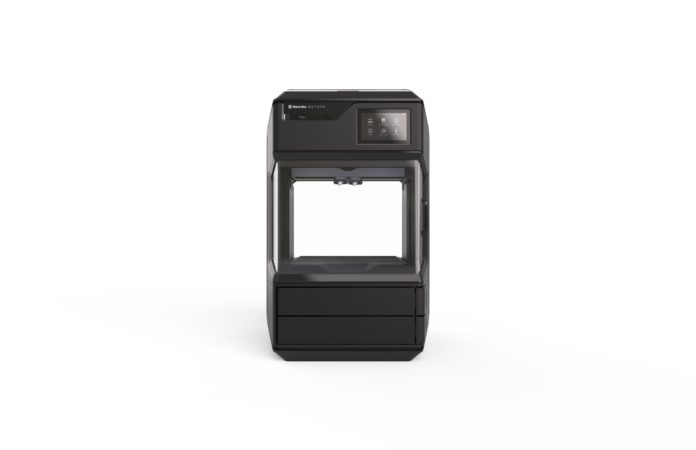Generally speaking, the term “pilot” is meant to be the testing ground to gauge a new product. In the TV world for instance, it is a standalone episode of a television series that is used to sell the show to a television network. In the industry, a production line is set up usually during engineering or manufacturing development, to test new methods, processes, and systems. We wanted to discover more about it the additive manufacturing industry and we asked MakerBot a few questions.
We are almost sure that MakerBot is a company that does not require further introduction but let’s follow the rules and introduce the manufacturer.
MakerBot is an American desktop 3D Printer manufacturer. The adventure officially started 10 years ago, in January 2009 with Bre Pettis, Adam Mayer, and Zach “Hoeken” Smith and 6 years ago, the company has become a Stratasys company. Over time, the company has built a unique positioning in bringing 3D printing to students.
As some companies of the industry, we have witnessed a sort of “quiet period” in the company’s activities but with Nadav Goshen as CEO, the company has opened a new chapter of its history, a chapter in which we have witnessed the launch of new FDM 3D Printers including Method & Method X, 2 FDM 3D Printers that integrate industrial 3D Printing features.
In this article, Dave Veisz, Vice President of Engineering, MakerBot has shared the company’s insights into FDM technology. This article aims to present an overview of a manufacturing process of a product, a 3D printer especially. More importantly, it will question the importance of FDM technology in a pilot program of a given product.
Pilot program of a 3D Printing system
Every year, several 3D Printers are unveiled in the 3D Printing community. Each of them aims to be the gamechanger for makers, engineers and companies. In such a competitive market, the consumer is lost and does not know who to turn to.
Furthermore, only a few numbers of manufacturers are willing to share some insights into the process they follow to launch their product. Yet, such process might enable to evaluate the efforts invested to deliver a premium product and help the user in his decision-making process.
As explained earlier, a pilot program is an experimental trial that helps a company how a large-scale project might work in practice. Even though we do not question the advantages of such trial, it should be noted that running a pilot program varies from one company to another. So far, we haven’t yet seen a defined guide applied by manufacturers of 3D Printing systems.
Two years ago, Impossible Objects, a manufacturer that develops composite-based additive manufacturing method (CBAM) launched its AM System Model One. During the initial pilot program, the US-based manufacturer has performed several tests with a select number of customers who included Jabil, a product solutions company, and select Fortune 500 customers whose names were not unveiled.

We have seen that the development of a desktop 3D Printer was slightly different:
“In the development of the MakerBot METHOD 3D Printer, for example, there were several milestones build and test cycles leading up to the start of serial production and shipping. The initial builds are using primarily prototype (3D printed plastics, machined metals, quick turn electronics), but as the design matures, the builds become more production representative and consist of a mix of tooled parts and rapid prototyped parts, and the numbers of units increase so that more thorough testing can be performed.
For a new platform like METHOD, a “pilot run” for MakerBot is generally at least 100 full assemblies so that we have enough units to perform statistically relevant testing for reliability and performance as well as the manufacturing process and in-line quality control. One unit may be adequate for proving out early stage proof of concept, but for a Pilot run, the quantity needs to be enough to sufficiently test the variability in part quality and the manufacturing process”, explains Dave Veisz.
This procedure has been applied to MakerBot METHOD 3D Printer. Other manufacturers certainly adopted a similar path but we can’t confirm it right now.
Now, before the launch of a consumer product, are processes exactly the same?
FDM 3D Printing and the launch of new products
FDM 3D Printing is without any doubt the most widely used technology in the additive manufacturing industry. It has become a technology of choice for both makers and enthusiasts that wish to discover 3D printing and also for some companies of the industry in their production facility.
“FDM printers are used in primary schools to introduce students to design thinking and other STEAM topics, but are also used to produce end-use aerospace and defense parts that have extremely demanding requirements. Therefore, FDM printers cover a very wide range of use cases. FDM printing is a great introduction to 3D printing because it is an accessible and safe 3D printing process that does not require hazardous chemicals, or secondary processes to create a usable part quickly” said MakerBot Vice President of Engineering.
As far as companies are concerned, market testing and pilot production remain one of the most expensive parts of launching a new product. Indeed, with conventional manufacturing processes, small run tooling can quickly become expensive, especially if the part design regularly changes. And obviously, not trying every single idea/design can result in investing in a product that will not perform well in the market.
Pilot production with 3D Printing offers an alternative to this issue. Indeed, using 3D Printers, manufacturers can produce one prototype, small to mid-volume production runs of a product without any of the tooling cost. Furthermore, in most cases, these 3D printers remain FDM 3D Printers. For MakerBot’s Dave Veisz, several reasons can justify the choice for FDM but as volume goes up, the need to consider tooling will become more obvious:
“Many companies are doing this in addition to using FDM 3D printers for the production of serial production parts. The main criteria are the requirements of the part (material properties, mechanical loading, etc.) to determine if FDM is the right technology in terms of capabilities, and the second consideration is economics. FDM is easy to justify for high mix, low volume production as there are no large expenditures or lead times for tooling in FDM parts in comparison to molded or other near net shape processes.
However, as volume goes up, dedicated tooling becomes more justifiable over FDM due to generally lower piece prices over the life of the product. Another point to make here is that there are part geometries that are possible to create in FDM that are not possible to create by traditional manufacturing methods. This includes designs with internal voids or variable cross-sections and dynamic “print-in-place” assemblies. Thus, high-tech industries like medical, aerospace, and advanced manufacturing are designing production parts that take advantage of the freedom of 3D printing and reducing part counts, improving strength to weight ratios, and achieving other advantages that justify the use of FDM in manufacturing production parts.”
FDM 3D Printing is therefore an interesting alternative that allows startups and design firms to do market testing affordably and quickly; not to mention that its affordability makes it possible to do more tests then normal.
The next question that crosses our mind then is to know the characteristics of ideal FDM 3D Printers for pilot production.
Key features to consider when choosing FDM 3D Printers for pilot production
When it comes to FDM technology, the user will mostly pay attention to the printer parameters, warping, layer adhesion, support structure, infill & shell thickness, materials and post-processing stage.
As far as printer parameters are concerned, from a designer’s perspective, build size and layer height are very important.
Warping is a common defect in FDM. When the extruded material cools during solidification, its dimensions decrease but here again, the operator can reduce this probability by choosing a 3D printer with large flat areas or by choosing different materials.
Moreover, if infill and shell thickness affect the strength of a component, the material used on the other hand, may affect the mechanical properties and accuracy of the printed part. And the thing is that there is a wide range of materials available for FDM. They range from commodity thermoplastics (such as PLA and ABS) to engineering materials (such as PA, TPU, and PETG) and high-performance thermoplastics (such as PEEK and PEI).
Lastly, an array of post-processing techniques exists. Some of them include sanding and polishing, priming and painting, cold welding, vapor smoothing, epoxy coating and metal plating.
In a nutshell, nothing is neither all black or all white when it comes to 3D Printing. Every single feature plays a key role in the user experience and will determine if he will renew his experience with the 3D Printer. Unfortunately, the issue encountered while using a specific 3D printer is not necessarily the same with the FDM technology of another manufacturer.
That’s certainly the reason why Dave Veisz lays emphasis on the rendering of the 3D printed part:
“The ideal characteristics of FDM printers are the incorporation of controls and features that enable the user to print accurately, repeatedly, and reliably. You need to be able to trust that the 3D printed part is an accurate representation of the design and that the part will have the same properties each time it is printed. In manufacturing, variability is the enemy, so you want a printer that has enclosed, sealed material bays to keep material dry and an enclosed, temperature-controlled chamber so there is consistency in the quality of the print regardless of the environment. Material capabilities per printer platform vary, so that will be consideration.
The other consideration is whether support material is required and the type of support (breakaway vs. soluble). With soluble support, it is possible to print geometry with voids and small support inclusions whereas certain geometries are not capable with breakaway support. There is a wide variety of cost options and the claims that manufacturers are making can be confusing. There is a difference between being able to print a material, and being able to print a material accurately and repeatedly. Accuracy and repeatibility really do require the “industrial” feature set regarding controlled printer and material environments and soluble support in order to reduce process variability and allow geometric freedom.”
Disclaimer: this article has originally been published in the 2019 August issue of 3D ADEPT Mag
Remember, you can post job opportunities in the AM Industry on 3D ADEPT Media free of charge or look for a job via our job board. Make sure to follow us on our social networks and subscribe to our weekly newsletter : Facebook, Twitter, LinkedIn & Instagram ! If you want to be featured in the next issue of our digital magazine or if you hear a story that needs to be heard, make sure to send it to contact@3dadept.com




